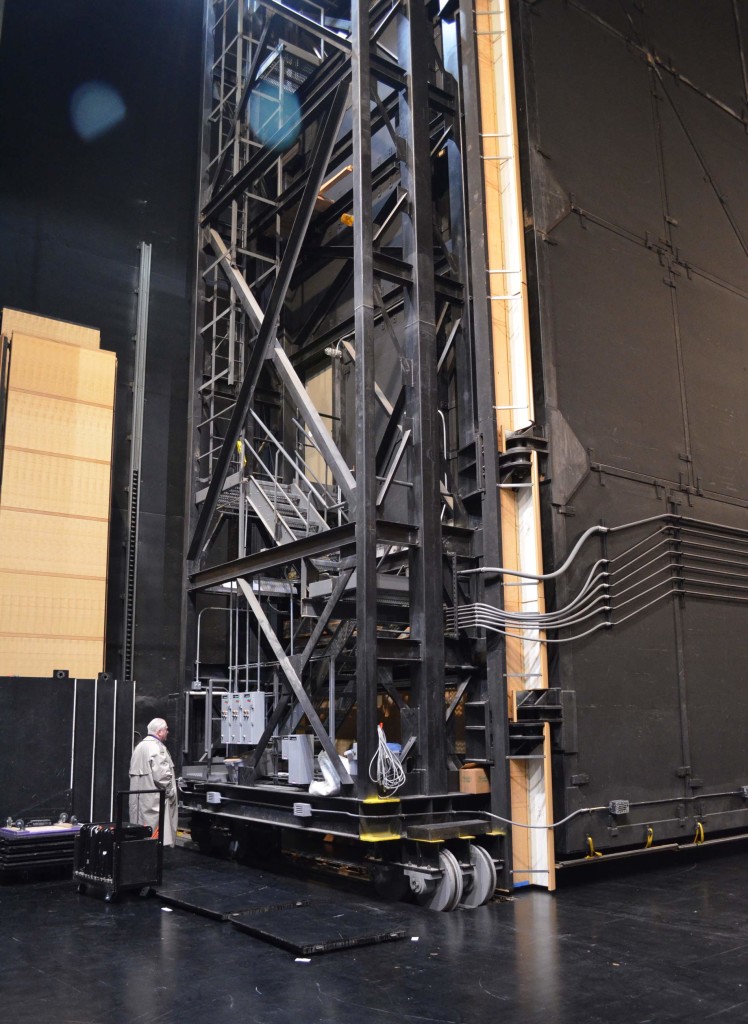The Uncommon Space – Building Volume, Part 1
The Uncommon Space
Building Volume, Part 1

The author contemplates the large orchestra enclosure system at Overture Center for the Arts, Madison, WI. The shell is in the storage position. Photo by Paul Sanow, ASTC.
Determining the cost of a building is most difficult during the pre-schematic and schematic design phases at the beginning of a project. At the end of the construction documents phase, it is reasonably simple (if not drudgery) to do the take offs from the design drawings and to estimate probable costs for labor, material and equipment.
At the beginning of design, you may know only the purpose and approximate size of the desired building. For some building projects with more typical goals and standards, such as warehouses, office buildings, retail shopping, or educational space this may be enough for a starting budget. But for complex, uncommon building types, predicting costs and setting a budget before doing the design work is especially challenging
Theatres, concert halls and other public assembly venues are uncommon and complex. Each year billions of square feet of commercial construction are built. With performance venues, perhaps only a few million square feet are constructed. There is also great variety in program and features for the performance buildings constructed each year.
Construction cost data in the US is compiled by the Census Bureau and by private companies who analyze and sell up to date data to designers, contractors, and consultants for use in estimating new projects. Two well-known construction cost providers in the US are Design Cost Data/BNi and Gordian/RSMeans. Both companies publish construction cost data in many forms.
If you attempt to research the square foot cost of a performance building, you will be disappointed. For the online RSMeans product, there are no entries for theatres. There is one entry for an auditorium (which might be typical for a small school). Likewise, information on performance equipment costs is limited. Typically, you can only find seating and stage lighting equipment. Unless you are experienced in designing and building theatres, these sources may provide partial information resulting in an inaccurate cost estimate. To further complicate cost estimating, it is customary for the bulk of the performance equipment to be included in the construction cost, while a smaller but significant amount of the equipment may be provided in the Fixtures, Furnishings and Equipment allowance carried in the Soft Cost category.
If you want detailed material and labor costs for running 100 feet of 1-inch conduit with, seven #10AWG conductors, you can find accurate detailed costs with multipliers for general conditions, overhead and profit, and site location. If the theatre design is completed, then the cost data from these companies will be of greater value.
Since performing arts venues are both uncommon and vary greatly in type, size, proposed use, required equipment, and level of finishes, the best source for cost data early in the project is to consult with an ASTC Member who specializes in this building type. An ASTC Member can also recommend a qualified performing arts cost consultant who is able to provide the necessary empirical and historical cost data that is critical in the development of an accurate and informed cost estimate.
By R. Duane Wilson, ASTC
Disclaimer: Any views or opinions expressed in this article are solely those of the author and do not necessarily represent those of the American Society of Theatre Consultants. This article is for general information only and should not be substituted for specific advice from a Theatre Consultant, Code Consultant, or Design Professional, and may not be suitable for all situations nor in all locations.


